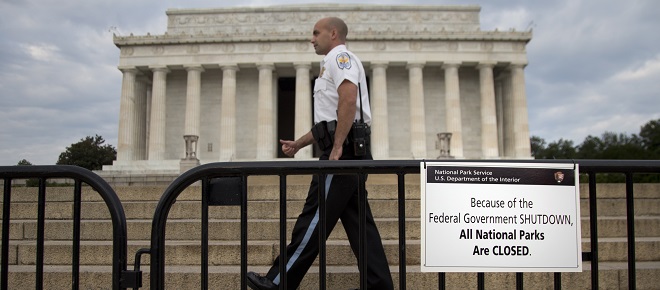The U.S. government shutdown: If America sneezes…
… what happens to Canada’s economy?
A US Park Police officer walks behind a barricade with sign reading “Because of the Federal Government SHUTDOWN All National Parks are Closed” in front of the Lincoln Memorial in Washington, Tuesday, Oct. 1, 2013. Congress plunged the nation into a partial government shutdown Tuesday as a long-running dispute over President Barack Obama’s health care law stalled a temporary funding bill, forcing about 800,000 federal workers off the job and suspending most non-essential federal programs and services. (AP Photo/Carolyn Kaster)
Share

When the U.S. sneezes, goes the adage, Canada catches a cold. In the case of a U.S. government shutdown, though, it should probably read the other way around: When the U.S. catches a cold, Canada sneezes.
That’s because, while the Canadian economy is very sensitive to whatever happens to U.S. consumers and private companies, we’re not quite so closely linked to the public sector. There aren’t that many Canadian firms that depend directly on the U.S. government for their business.
The last time the U.S. went through a partial government paralysis in 1995-1996 — for roughly four weeks in two separate instances — our economic growth slowed by a quarter of a percentage point during the last three months of 1995. A two-weeks shutdown this time around could shave a decimal place off Canada’s growth rate in the fourth quarter, estimates Avery Shenfeld, chief economist of CIBC World Markets. So, if you were projecting growth of 2.2 per cent, it might be 2.1. “The impact of two-week shutdown would be lost in the decimal places of measuring Canadian GDP,” Shenfeld told CBC. With Canada expected to grow in the range of 2-2.5% between October and December, that really doesn’t sound too bad.
The danger, though, is that Uncle Sam’s cold turns into a full-blown flu. A few days or a couple of weeks of shutdown is an inconvenience. Many government employees and contractors will have to make do with a little less cash, as Washington freezes pay and payments. Canadian truck drivers crossing over into the U.S. will likely have to put up with longer lines, as U.S. border agents might not put in overtime, even though they are exempt from furloughs.
A prolonged shutdown, though, would take a sizable toll. Unpaid U.S. contractors might be unable to pay their employees and creditors on time. Families of government employees might have to trim consumption. The backlog at the border could turn into gridlock, and Canadian exporters would lose money and business opportunities.
Add it all up, and a long federal government freeze could trim U.S. growth by 1.4%, reports the Washington Post’s Zachary Goldfarb. That means the economy would barely expand during the all-important Christmas season. “A longer shutdown, could significantly impede the economic recovery,” Craig Alexander, chief economist at TD Bank Group, wrote yesterday in a note to clients.
Keep your fingers crossed it doesn’t come to that.